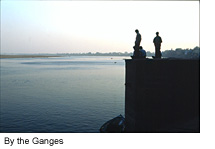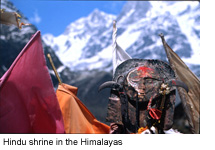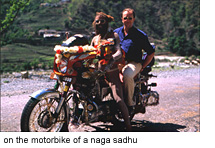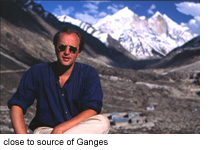Shiva's
Matted Locks - Programme 1
Monday, April 3rd, 7.10
William Dalrymple makes an epic journey along a well-worn route travelled
by thousands of pilgrims before him to find the source of the River Ganges.
 |
Long-venerated
as the most sacred of all rivers, Mother Ganges is considered to be one
of the fonts of Hindu worship. It is on its banks in the town of Hardwar
that every 12 years a remarkable festival, the Kumbh Mela, is held.
www.lonelyplanet.com
"A small market town the size of Saffron Walden is transformed overnight
into a heaving metropolis bigger than New York," says William.
Around 10 million people from all corners of India gather at the Kumbh
Mela to wash, worship and give thanks on the banks of the Ganges. Many
of them, like William, then start out on the long journey from the plains
up through the foothills of the Himalayas and on to the river's source
15,000ft into the High Himalayas, near to the border of Tibet.
 |
The journey,
as William discovers, throws a fascinating light on Hinduism. It's a religion
that has no founding father and no single sacred scripture, yet it has
surpassed all other religions in its longevity.
"The ritual of bathing in the Ganges is described in India's oldest sacred
text - the Rig Veda - written when both the Pyramids and Stonehenge were
still in use yet, while Isis, Zeus and other deities from the ancient
world have long been forgotten, the River Ganges is now more revered than
ever."
Legend has it that Mother Ganges came down from the heavens and was tamed
by Lord Shiva on the slopes of the Himalayas, known to Hindus as the locks
of Shiva. The two great gods were united and thus the two forces of nature
have long-held an important place in the Hindu religion.
On his pilgrimage, William meets several of India's sadhus - holy men
who have renounced the world for an ascetic life. One of them is a naked
'naga sadhu' - a holy man who smears himself in ash, has no possessions
and no clothes - who invites William to ride pillion on his Enfield Bullet
motorbike.
 |
It did
pose one tricky question," says William. "
If you are riding pillion with a naked holy man, where do you put your
hands?"
One of the most moving moments of William's trek comes when he reaches
the Great Temple of Kedarnath - a shrine to Lord Shiva.
Pilgrims come to the shrine, many barefoot and dressed only in the slightest
of shawls in snow and sub-zero temperatures to pay homage to the statues
of Lord Shiva.
Say William: "Anyone brought up within the relatively unemotional church
services of the West can't help but be profoundly struck by the intensity
of these scenes of religious devotion."
 |
His journey
ends at Gangotri www.indiatouristoffice.co.uk,
the traditional source of the Ganges, after almost three weeks of walking
through searing daytime heat and freezing nights spent camping out at
the various stations along the way.
"The Ganges emerges from a crystal amphitheatre of solid ice. You do not
have to be a Hindu to feel that this deserted, windswept wasteland at
the source of the Ganges is one of the most extraordinary and suggestive
places on the face of the earth - where the divine touches on the mundane
and the human."
Links: Gangotri: www.indiatouristoffice.co.uk
Lonely Planet North India: www.lonelyplanet.com
Chipko conservation movement: http://iisd1.iisd.ca/50comm/commdb/list/c07.htm
http://www.the-week.com/97dec07/events2.htm